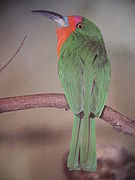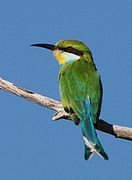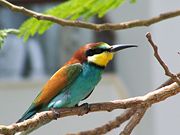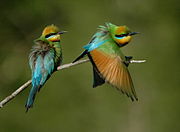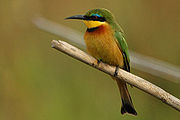- Bee-eater
-
Bee-eaters 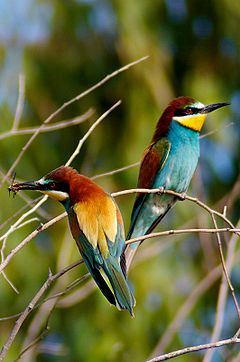
European Bee-eaters, (Merops apiaster) Scientific classification Kingdom: Animalia Phylum: Chordata Class: Aves Order: Coraciiformes Family: Meropidae
Rafinesque, 1815Genera The bee-eaters are a group of near-passerine birds in the family Meropidae. Most species are found in Africa and Asia but others occur in southern Europe, Australia, and New Guinea. They are characterised by richly coloured plumage, slender bodies, and usually elongated central tail feathers. All have long downturned bills and pointed wings, which give them a swallow-like appearance when seen from afar. There are 26 different species of bee-eaters.
As the name suggests, bee-eaters predominantly eat flying insects, especially bees and wasps, which are caught in the air by sallies from an open perch.[1] While they pursue any type of flying insect, honey bees predominate in their diet. Hymenoptera (ants, bees and wasps) comprise from 20% to 96% of all insects eaten, with honey bees comprising approximately one-third of the Hymenoptera.[2]
Before eating its meal, a bee-eater removes the sting by repeatedly hitting and rubbing the insect on a hard surface. During this process, pressure is applied to the insect thereby extracting most of the venom.[1] Notably, the birds only catch prey that are on the wing and ignore flying insects once they land.
Bee-eaters are gregarious. They form colonies by nesting in burrows tunnelled into the side of sandy banks, such as those that have collapsed on the edges of rivers. Their eggs are white and they generally produce 2-9 eggs per clutch (depending on species). As they live in colonies, large numbers of these holes are often seen together, white streaks from their accumulated droppings accentuating the entrances to the nests. Most of the species in the family are monogamous, and both parents care for the young, sometimes with the assistance of other birds in the colony.[1]
Contents
Description
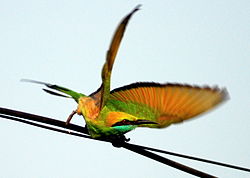 Green Bee-eater at take-off
Green Bee-eater at take-off
The bee-eaters are a fairly uniform group, morphologically. They share many features with related Coraciiformes such as the kingfishers and rollers, being large-headed (but not as large-headed as their relatives) short-necked, brightly plumaged and short-legged. Their wings may be rounded or pointed, with wing shape closely correlated with foraging habitat and migratory tendencies. Shorter, rounder wings are found on species that are sedentary and make shorter foraging flights in denser forests and reedbeds. Those with more elongated wings are more migratory. All the bee-eaters are highly aerial. They take off strongly from perches, fly directly without undulating, and are able to change directions quickly. Bee-eaters rarely hover, however.[3]
The bills of bee-eaters are curved, long and end in a sharp point. The bill can bite strongly, particularly at the tip, and is used as a pair of forceps with which to snatch insects from the air and crush smaller ones. The short legs have weak feet, when moving on the ground its gait is barely more than a shuffle. The feet have sharp claws used for perching on vertical surfaces and also during nest excavation.[3]
The plumage of the family is generally very bright and in most species dominated or at least partly green. The two carmine bee-eaters are mostly rosy coloured. Most of the Merops bee-eaters have a line through the eye and many have differently coloured throats and faces. The extent of the green in these varies from almost completely in the Green Bee-eater to barely any in the White-throated Bee-eater. Three species, from equatorial Africa, have no green at all in their plumage, the Black Bee-eater, the Blue-headed Bee-eater and the Rosy Bee-eater. Several species have long streamers in the tail, and in a few species these are ended with expanded spatulae.[3]
There is little visible difference between the sexes in most of the family. In several species the iris is red in the males and brown-red in the females, and in species with tail-streamers these may be slightly longer in males. Both the European and Red-bearded Bee-eaters have differences in the colour of their plumage, and the Rainbow Bee-eaters have differently shaped tail-streamers.[3] There are however probably undocumented instances where bee-eaters are sexually dichromatic in the ultraviolet end of the colour spectrum, which humans cannot see. A study of Blue-tailed Bee-eater found that males were more colourful when comparisons between males and females included a comparison of their plumage in the UV spectrum. Overall colour also was affected by body condition, suggesting that there was a signalling component to plumage colour.[4]
Distribution, habitat and migration
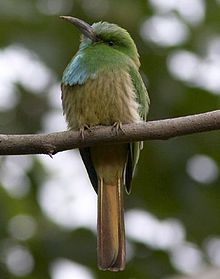 The Blue-bearded Bee-eater is associated with rainforests, where it forages in edge habitats
The Blue-bearded Bee-eater is associated with rainforests, where it forages in edge habitats
The bee-eaters have an Old World distribution, occurring from Europe to Australia. The centre of diversity of the family is Africa, although a number of species also occur in Asia. A single species occurs in Europe, the European Bee-eater and Australia, the Rainbow Bee-eater; and there is one Madagascar species, the Olive Bee-eater (also found on mainland Africa). Of the three genera, Merops, which has the majority of the species in the family, occurs across the entirely of the family's distribution. Nyctyornis is restricted to Asia, ranging from India and southern China to the Indonesian islands of Sumatra and Borneo. The genus Meropogon, has a single species restricted to Sulawesi in Indonesia.[3]
Bee-eaters are fairly catholic in their habitat. Their requirements are a simply an elevated perch from which to watch for prey and a ground substrate in which to dig their breeding burrow. Because their prey is entirely caught on the wing they are not dependent on any vegetation type. A single species is found inside closed rainforest, the Blue-headed Bee-eater, where it forages close to the ground in poor light in the gaps between large trees under the canopy. Six other species are also closely associated with rainforest, but do so in edge habitat in this environment; along rivers, in tree-fall gaps, off trees overhanging ravines or on emergent crowns above the main canopy.[3]
A number of the bee-eaters are migratory. Species that breed in subtropical or temperate areas of Europe, Asia and Australia are all migrants. The European Bee-eaters that breed in southern Europe and Asia migrate to West and Southern Africa. Another population of the same species breeds in South Africa and Namibia; these birds move northwards after breeding. In Australia the Rainbow Bee-eater is migratory in the southern areas of its range, migrating to Indonesia and New Guinea, but occurs year round in northern Australia. Several species of bee-eater, such as the White-throated Bee-eater, are intra-African migrants.[3] The most unusual migration is that of the Southern Carmine Bee-eater, which has a three stage migration; after breeding in a band between Angola and Mozambique it moves south to Botswana, Namibia and South Africa before moving north to its main wintering grounds in northern Angola, Congo and Tanzania.[5]
Behaviour
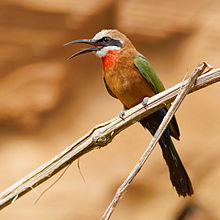 The White-fronted Bee-eater has a complex colonial social life
The White-fronted Bee-eater has a complex colonial social life
 Green Bee-eaters dust bathing to keep down parasites
Green Bee-eaters dust bathing to keep down parasites
The bee-eaters are diurnal (active by day) although a few species may migrate during the night if the terrain on route is unsuitable for stopping or if they are crossing the sea. They are a highly social family. Pairs sitting together are often so close together that they touch (described as having an individual distance of zero). Groups may roost together in a row in such a fashion as well. Some species are highly gregarious in the non-breeding season, and many species are colonial in the breeding season as well.
The social structures of the Red-throated Bee-eater and the White-fronted Bee-eaters have been described as "the most complex of any bird species anywhere in the world".[6] The birds exist in stable colonies located on nesting cliffs, and have a stable structure year round. These colonies are composed of clans of two or three pairs, their helpers, and offspring. Within the colony the males alternate between guarding their mate and attempting to make forced copulations other females.[7] The females in turn attempt to lay eggs in their neighbour's nests. Within colonies some individuals also specialise in kleptoparasitism, stealing prey collected by other colony members. The colony's daily routine is emerge from the nesting holes or roosting branches soon after dawn, preen and sun themselves for an hour, then disperse to feed. Feeding territories are broken down by clan, with the clan defending the territories from all others of the same species, including clans of the same colony.[8] The clans return to the colony before dusk, and engage in more social behaviour before retiring for the night. Colonies are situated several hundred metres apart and have little to do with each other, although young individuals may disperse between colonies. As such these species can be thought to have four tiers of social kinship, the individual pair, the family unit, the clan and the colony as a whole.[3]
Bee-eaters spend around 10% of their day on what are known as comfort activities. These include sunning themselves, dust bathing and water bathing. Sunning behaviour helps warm birds in the morning, reducing the need to use energy to raise the temperature. It also has a social aspect, as multiple birds adopt the same posture. Finally, it may help stimulate parasites in the feathers, making them easier to find and remove. Due to their hole-nesting bee-eaters accumulate a number of ectoparasites such as mites and flies. Together with sunning bouts of dust bathing (or water bathing where available), as well as rigorous preening, keep the feathers and skin in good health. Bathing with water involves making shallow dives into a water body and then returning to a perch to preen.[3]
Diet and feeding
The bee-eaters are almost exclusively aerial hunters of insect prey. Prey is caught either while in continuous flight or more commonly from an exposed perch where the bee-eater watches for prey. Smaller, rounder-winged bee-eaters typically hunt from branches and twigs closer to the ground, whereas the larger species hunt from tree tops or telegraph wires. One unusual technique often used by carmine bee-eaters is to ride the back of bustards. Prey can be spotted from a distance; European Bee-eaters are able to spot a bee 60 m away, and Blue-cheeked Bee-eaters have been observed flying out 100 m to catch large wasps. Prey is approached directly or from behind. Prey that lands on the ground or on plants is usually not pursued. Small prey may be eaten on the wing, but larger prey are returned to the perch to be beaten against the perch to kill them and break them up. Insects with poisonous stings are first smacked on the branch, then, with the eyes closed, rubbed to discharge the venom. This behaviour is innate, as demonstrated by a juvenile bird in captivity, which performed the task when first presented with wild bees. This bird was stung on the first five tries, but by ten bees, it was as adept at handling bees as adult birds.[3]
Bee-eaters consume a wide range of insects; beyond a few distasteful butterflies they consume almost any insect from tiny Drosophila flies to large beetles and dragonflies. At some point bee-eaters have been recorded eating beetles, mayflies, stoneflies, cicadas, termites, crickets and grasshoppers, mantises, true flies and moths. For many species the dominant prey item are stinging members of the order Hymenoptera, namely wasps and bees. In a survey of 20 studies the proportion of the diet made up by bees and wasps varied from 20% to 96%, with the average being 70%. Of these honeybees can comprise a large part of the diet - as much as 89% of the overall diet.[3]
Breeding
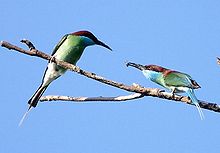 A male Blue-throated Bee-eater presents his mate with a captured insect
A male Blue-throated Bee-eater presents his mate with a captured insect
Bee-eaters are seasonally monogamous, and some species are monogamous over multiple seasons. Migratory species however are thought to form new pair bonds each breeding season. The courtship displays of the bee-eaters are rather unspectacular, with the exception of the "butterfly display" (where the wings of both sexes are held out while calling) of the White-throated Bee-eater. Most members of the family engage in courtship feeding, where the male presents prey items to the female, and such feeding can account for much if not all of the energy females require for egg creation.[9]
Like almost all Coraciiformes the bee-eaters are cavity nesters.[10] In the case of the bee-eaters the nests are burrows dug into the ground, either into the sides of earth cliffs or directly into level ground. Both types of nesting site are vulnerable, those on level ground are vulnerable to trampling and small predators, whereas those in cliffs, which are often the banks of rivers, are vulnerable to flash floods, which can wipe out dozens or hundreds of nests. Many species nest either on cliffs or on level ground but prefer cliffs, however the Böhm's Bee-eater always nests on level ground. The burrows are dug by both birds in the pair as well as any helpers that have joined the pair. The soil or sand is loosened with jabs of the sharp bill, then the feet are used to kick out the loose substrate. There may be several false starts where nests are dug partway before being abandoned; in solitary species this can give the impression of colonial living even when they are not. The process of nest building can take as long as twenty days to complete, during which the bill can be both blunted and shortened. Nests are generally used only for a single season and are rarely used twice by the bee-eaters, but abandoned bee-eater nests may be used by a host of birds, snakes and bats as shelter and breeding places.[11]
Bee-eaters may nest as single pairs, loose colonies or dense colonies. Smaller species tend to nest solitarily, while medium sized species do so in the smaller colonies and larger and migratory species nest in large colonies that can number in the thousands. In some instances colonies may contain more than one species of bee-eater.[12]
Species list in taxonomic order
The bee-eater family consists of two subfamilies - the bearded bee-eaters Nyctyornithinae, and Meropinae, the typical bee-eaters.[citation needed]
FAMILY: MEROPIDAE
- Genus: Nyctyornis
- Red-bearded Bee-eater, Nyctyornis amictus
- Blue-bearded Bee-eater, Nyctyornis athertoni
- Genus: Meropogon
- Purple-bearded Bee-eater, Meropogon forsteni
- Genus: Merops
- Little Bee-eater, Merops pusillus
- Blue-cheeked Bee-eater, Merops persicus
- Green Bee-eater, Merops orientalis
- White-throated Bee-eater, Merops albicollis
- Swallow-tailed Bee-eater, Merops hirundinaeus
- Blue-tailed Bee-eater, Merops philippinus
- Black Bee-eater, Merops gularis
- Blue-headed Bee-eater, Merops muelleri
- Red-throated Bee-eater, Merops bulocki
- White-fronted Bee-eater, Merops bullockoides
- Blue-breasted Bee-eater, Merops variegatus
- Cinnamon-chested Bee-eater, Merops oreobates
- Black-headed Bee-eater, Merops breweri
- Somali Bee-eater, Merops revoilii
- Böhm's Bee-eater, Merops boehmi
- Blue-throated Bee-eater, Merops viridis
- Olive Bee-eater, Merops superciliosus
- Rainbow Bee-eater, Merops ornatus
- European Bee-eater, Merops apiaster
- Chestnut-headed Bee-eater, Merops leschenaulti
- Rosy Bee-eater, Merops malimbicus
- Northern Carmine Bee-eater, Merops nubicus
- Southern Carmine Bee-eater, Merops nubicoides
Red-bearded Bee-eater (Nyctyornis amictus)Green Bee-eater (Merops orientalis)Swallow-tailed Bee-eater (Merops hirundineus)Blue-tailed Bee-eater (Merops philippinus)European Bee-eater (Merops apiaster)Rainbow Bee-eater (Merops ornatus)Little Bee-eater (Merops pusillus)References
- ^ a b c Forshaw, J. & Kemp, A. (1991). Forshaw, Joseph. ed. Encyclopaedia of Animals: Birds. London: Merehurst Press. pp. 144–145. ISBN 1-85391-186-0.
- ^ Fry, Fry and Harris, Kingfishers, Bee-eaters, and Rollers (1992) ISBN 978-0-7136-8028-7
- ^ a b c d e f g h i j k Fry, Hilary (2001). "Family Meropidae (Bee-eaters)". In del Hoyo, Josep; Elliott, Andrew; Sargatal, Jordi. Handbook of the Birds of the World. Volume 6, Mousebirds to Hornbills. Barcelona: Lynx Edicions. pp. 286–325. ISBN 978-84-87334-30-6.
- ^ Siefferman, Lynn; Wang, Yuan-Jyun; Wang, Yi-Ping; Yuan, Hsiao-Wei (2007). "Sexual dichromatism, dimorphism, and condition-dependent coloration in blue-tailed bee-eaters". Condor 109 (3): 577–584. doi:10.1650/8201.1.
- ^ Hoare, Ben (2009). Animal migration: remarkable journeys in the wild. University of California Press. p. 148. ISBN 9780520258235.
- ^ Fry, (2001) p. 298
- ^ Emlen, S.T.; P.H. Wrege (1996). "Forced copulations and intra-specific parasitism: two costs of social living in the white-fronted bee-eater". Ethology 71 (1): 2–29. doi:10.1111/j.1439-0310.1986.tb00566.x. ISSN 0179-1613.
- ^ Hegner, Robert E.; Emlen, Stephen & Natalie J. Demong (1982). "Spatial organization of the white-fronted bee-eater". Nature 298 (5871): 264–266. doi:10.1038/298264a0.
- ^ Avery, M. I.; Krebs, J. R.; Houston, A. I. (1988). "Economics of courtship-feeding in the European bee-eater (Merops apiaster)". Behavioural Ecology and Sociobiology 23 (2): 61–67. doi:10.1007/BF00299888.
- ^ Eberhard, Jessica (2002). "Cavity adoption and the evolution of coloniality in cavity-nesting birds". Condor 104 (2): 240–247. doi:10.1650/0010-5422(2002)104[0240:CAATEO]2.0.CO;2. ISSN 0010-5422.
- ^ Casas-Crivillé, A.; F. Valera (2005). "The European bee-eater (Merops apiaster) as an ecosystem engineer in arid environments". Journal of Arid Environments 60 (2): 227–238. doi:10.1016/j.jaridenv.2004.03.012.
- ^ Kossenko, S.M.; Fry, C.H. (1998). "Competition and coexistence of the European Bee-eater Merops apiaster and the Blue-cheeked Bee-eater Merops persicus in Asia". Ibis 140 (1): 2–13. doi:10.1111/j.1474-919X.1998.tb04535.x.
External links
- Camacdonald Gallery of each species
- Bee-eater videos on the Internet Bird Collection
- Meropidae, Bird families of the World
Categories:- Meropidae
- Bird families
- Genus: Nyctyornis
Wikimedia Foundation. 2010.

